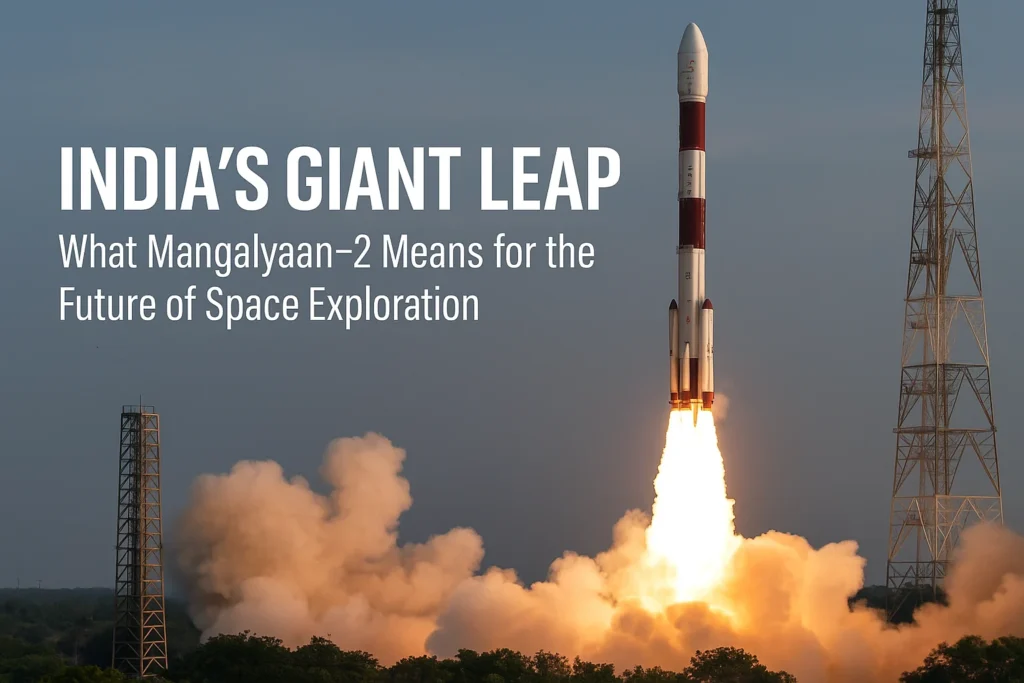Introduction: A New Era for Indian Space Ambition
From the ancient wisdom that mapped constellations to modern-day rockets piercing the sky, humanity has always looked to the heavens with wonder. For India, this celestial gaze has transformed into a determined stride, marked by missions that combine ingenuity with remarkable cost-effectiveness. In 2014, the Indian Space Research Organisation (ISRO) etched its name in history with Mangalyaan-1, or the Mars Orbiter Mission (MOM), successfully placing a spacecraft in Mars’ orbit on its very first attempt – a feat achieved by no other nation on its maiden voyage. Now, as the mid-2020s unfold, India stands on the cusp of another monumental achievement: the launch of Mangalyaan-2.
This isn’t just another mission; it’s India’s bold declaration of intent to push the boundaries of interplanetary exploration. With ambitious plans for a Martian lander, a rover, and even a pioneering helicopter, Mangalyaan-2 signifies a profound shift in ISRO’s capabilities and India’s global stature in the escalating “new space race.” What exactly does this upcoming mission entail, and how will it reshape our understanding of the Red Planet and India’s place among spacefaring giants? Let’s embark on this journey to Mars.
Mangalyaan-1: The Trailblazer’s Legacy
Before we look to the future, it’s essential to understand the foundation upon which Mangalyaan-2 is being built. Mangalyaan-1 was a triumph that captured the imagination of millions and stunned the global space community. Launched in November 2013, the spacecraft successfully entered Mars’ orbit in September 2014, making India the fourth entity (after NASA, the Soviet space program, and the European Space Agency) to achieve this feat, and notably, the first Asian nation to do so.
What truly set Mangalyaan-1 apart was its astonishing cost-effectiveness. Executed on a shoestring budget of approximately $74 million (significantly less than many Hollywood blockbusters), it showcased ISRO’s unique ability to achieve complex interplanetary missions with remarkable efficiency. This “frugal engineering” became a hallmark of India’s space program, demonstrating that high-tech space exploration didn’t necessarily require exorbitant spending.
Beyond its technological demonstration, MOM-1 delivered valuable scientific data. Its Mars Color Camera captured stunning images of the Martian surface, revealing intricate geological features, while its Methane Sensor for Mars provided crucial insights into the planet’s atmosphere. Though not designed for a long life, Mangalyaan-1 exceeded all expectations, operating for over eight years and continuing to send back data long past its initial six-month mission plan. Its success not only bolstered national pride but also firmly established India as a serious and capable player in the challenging arena of interplanetary space exploration.
Mangalyaan-2: A Bold New Blueprint for Mars
Building on the unparalleled success of its predecessor, Mangalyaan-2 represents a monumental leap for ISRO. While Mangalyaan-1 was an orbiter, designed to study Mars from above, Mangalyaan-2 is poised to directly touch down on the Martian surface, marking India’s first attempt at a soft landing on another planet. This mission is tentatively scheduled for launch no earlier than 2026, a testament to the meticulous planning and complex technological development required.
The new mission’s blueprint outlines a multi-component spacecraft, significantly heavier than Mangalyaan-1, weighing approximately 4,500 kg. It will be launched aboard ISRO’s powerful Launch Vehicle Mark-III (LVM3) rocket, capable of delivering the substantial payload directly onto an interplanetary trajectory.
Mangalyaan-2 will primarily consist of two main components: a Cruise Stage and a Descent Stage. The Cruise Stage will propel the spacecraft from Earth’s orbit towards Mars. Once near the Red Planet, the Descent Stage, carrying the lander, rover, and other instruments, will separate and directly enter the Martian atmosphere. This “direct entry” approach, bypassing the traditional step of first orbiting Mars before landing, is a bold technological move by ISRO, demanding extreme precision and cutting-edge autonomous capabilities. If successful, it will place India among an elite group of nations capable of such a complex maneuver.
Beyond Orbit: New Technologies for a Martian Touchdown
Landing on Mars is famously difficult. The planet’s thin atmosphere—about 100 times thinner than Earth’s—makes traditional parachutes less effective, while still being thick enough to cause significant friction and heat during entry. This critical phase, often dubbed the “seven minutes of terror” by NASA, requires perfect execution of a series of autonomous maneuvers. Mangalyaan-2 will deploy a suite of advanced technologies to ensure its safe arrival:
- Aerobraking: This technique utilizes the drag from Mars’ atmosphere to slow down the spacecraft, reducing the need for propellant.
- Supersonic Parachutes and Heat-Resistant Aeroshells: A robust aeroshell will shield the lander from the intense heat generated during atmospheric entry, followed by the deployment of massive supersonic parachutes to further reduce velocity.
- Powered Descent System: In the final moments before touchdown, advanced engines on the Descent Stage will ignite, providing a controlled guidance system for a precise and gentle landing on the challenging Martian terrain.
A standout feature that truly elevates Mangalyaan-2’s ambition is the inclusion of a mini-helicopter. Inspired by NASA’s highly successful Ingenuity drone, this rotorcraft will enable India to explore the Martian landscape from the air. Its role will be crucial for:
- Aerial Exploration: Surveying the immediate landing site and scouting potential paths for the rover.
- Atmospheric Profiling: Gathering data on Mars’ thin atmosphere and weather patterns from various altitudes.
- Enhanced Surface Mapping: Providing broader contextual views for the rover’s ground-level investigations.
The rover itself will be equipped with advanced technology for autonomous navigation and a suite of scientific instruments. Together, the lander, rover, and helicopter will allow for an unprecedented level of in-situ (on-site) exploration, far beyond the orbital observations of Mangalyaan-1.
Scientific Quest: What Mangalyaan-2 Aims to Uncover
At its core, Mangalyaan-2 is a mission of scientific discovery, aiming to peel back more layers of Mars’ enduring mysteries. The mission’s primary objectives are to conduct in-depth studies of the Martian surface composition, atmosphere, interplanetary dust, and environmental conditions. These investigations will contribute significantly to our understanding of Mars’ formation, its geological evolution, and, crucially, its potential for past or present habitability.
The mission is expected to carry four key scientific payloads, each designed to answer specific questions:
- Mars Orbit Dust Experiment (MODEX): This instrument will study the origin, abundance, distribution, and movement of dust at high altitudes in Mars’ atmosphere. Understanding Martian dust is crucial for future human missions, as dust storms can blanket the planet and pose significant challenges.
- Radio Occultation (RO) Experiment: By analyzing how radio signals from the spacecraft change as they pass through Mars’ atmosphere, this experiment will measure neutral and electron density profiles, providing insights into the planet’s atmospheric structure and dynamics.
- Energetic Ion Spectrometer (EIS): This payload will analyze the energetic particles in Mars’ environment, helping scientists understand the interaction between the solar wind and the Martian atmosphere, which is key to understanding how Mars lost most of its water and atmosphere over billions of years.
- Langmuir Probe and Electric Field Experiment (LPEX): This instrument will investigate the properties of Mars’ ionosphere, including plasma density and electric fields. Such data is vital for understanding the complex electrical environment near the Martian surface.
Through these sophisticated instruments and the mobility offered by the rover and helicopter, Mangalyaan-2 aims to provide a comprehensive picture of Mars, probing for clues about its past climate, the presence of subsurface water ice, and the conditions that might have once supported—or could still support—some form of life.
India in the New Space Race: Global Significance
The successful launch and operation of Mangalyaan-2 will not merely be a scientific triumph; it will be a profound statement about India’s growing prowess and influence in the global space arena. In what is increasingly termed the “new space race,” where more nations and even private companies are vying for a piece of the cosmic pie, Mangalyaan-2 will solidify India’s position as a formidable and innovative player.
- Joining the Elite Club: If Mangalyaan-2 successfully lands its spacecraft and deploys its rover and helicopter, India will join the United States, Russia, and China as one of only a handful of nations capable of achieving a controlled touchdown on Mars. This achievement would dramatically elevate ISRO’s international standing and showcase its advanced technological capabilities.
- The Power of Cost-Effectiveness: ISRO’s continued ability to execute highly complex missions at a fraction of the cost of its international counterparts remains a unique strength. This approach sets a new benchmark for space exploration, making deep-space missions more accessible and inspiring other nations to pursue their own ambitious endeavors.
- Strategic Autonomy and Collaboration: India’s space program emphasizes indigenous development, ensuring strategic autonomy. However, ISRO also actively seeks international collaborations, sharing knowledge and expertise. Mangalyaan-2’s success will enhance India’s appeal as a reliable and valuable partner in future global space ventures, such as lunar bases or even human missions to Mars.
- Inspiring the Next Generation: The visible success of such missions ignites national pride and, crucially, inspires young minds to pursue careers in science, technology, engineering, and mathematics (STEM). This cultivation of talent is vital for a nation’s long-term scientific and technological advancement.
In a global landscape where space capabilities are increasingly linked to geopolitical influence and technological leadership, Mangalyaan-2 is more than a scientific mission; it’s a strategic move that strengthens India’s voice and capabilities on the world stage.
Economic and Strategic Boost: More Than Just Science
The reverberations of a mission like Mangalyaan-2 extend far beyond scientific journals and mission control rooms. Such ambitious space endeavors have significant economic and strategic implications for the nation, acting as powerful catalysts for growth, innovation, and national development.
- National Pride and Soft Power: Few achievements galvanize a nation like a successful space mission. Mangalyaan-2 will undoubtedly be a source of immense national pride, boosting morale and unity among citizens. This “soft power” enhances India’s image as a technologically advanced and scientifically capable nation on the global stage.
- Catalyzing the Private Space Sector: ISRO’s groundbreaking missions serve as a powerful proof-of-concept for India’s burgeoning private space industry. The government, through bodies like IN-SPACe and NewSpace India Limited (NSIL), is actively promoting private sector participation, allowing domestic companies to engage in everything from satellite manufacturing to launch services. Successful missions like Mangalyaan-2 increase investor confidence and open up new commercial opportunities, creating jobs and fostering a vibrant space ecosystem. India aims to capture 8% of the global space market by 2033, growing its space economy to an impressive $44 billion.
- Technological Spin-offs and Innovation: The rigorous demands of interplanetary missions push the boundaries of engineering and technology. Innovations developed for Mangalyaan-2—in areas like advanced propulsion, autonomous navigation, robotics, heat shielding, and miniaturization—will have practical applications in various terrestrial sectors. These spin-offs can lead to advancements in communication, disaster management, agriculture (through satellite imagery), and even defense capabilities, creating ripple effects across the economy.
- Skill Development and Job Creation: The design, development, manufacturing, and operation of a mission like Mangalyaan-2 require a highly skilled workforce. This incentivizes investment in STEM education and training, leading to the creation of high-value jobs for scientists, engineers, technicians, and project managers, not just within ISRO but also in the burgeoning private aerospace sector.
Thus, Mangalyaan-2 is not merely a scientific expedition; it is a strategic investment in India’s future, reinforcing its technological independence, boosting its economy, and inspiring generations to come.
The Perils of Interplanetary Journeys: Challenges Ahead
Despite ISRO’s impressive track record, the journey to Mars remains one of the most challenging feats in space exploration. Mangalyaan-2, with its ambitious goals of landing and deploying instruments on the Martian surface, faces a multitude of technical and environmental hurdles that demand extreme precision and robust engineering.
- The Vast Distance and Communication Delays: Mars is millions of kilometers away from Earth. This immense distance means that radio signals, traveling at the speed of light, can take anywhere from 4 to 20 minutes for a one-way trip. Such significant communication delays necessitate that critical maneuvers, especially during the landing sequence, must be executed autonomously by the spacecraft, without real-time guidance from ground control.
- The “Seven Minutes of Terror” (Entry, Descent, and Landing – EDL): As mentioned earlier, the descent phase is arguably the most perilous. The spacecraft must transition from high-speed atmospheric entry to a gentle touchdown in a matter of minutes. This involves surviving extreme heat, deploying supersonic parachutes effectively in a thin atmosphere, and executing a powered descent with pinpoint accuracy. A single misstep can lead to catastrophic failure.
- The Challenging Martian Atmosphere: Mars’ atmosphere is very thin, posing difficulties for aerodynamic braking and the effective deployment of parachutes. For the mini-helicopter, flying in such a low-density environment requires innovative rotor design and power management, pushing the boundaries of aerial robotics.
- Rugged Martian Terrain: Mars is littered with craters, rocks, and uneven landscapes. The lander must identify and navigate to a safe landing site autonomously, avoiding hazards that could damage the spacecraft upon touchdown.
- Harsh Environmental Conditions: Mars is an unforgiving environment. The spacecraft and its instruments must withstand extreme temperature variations (from scorching days to frigid nights), abrasive dust storms that can obscure solar panels and delicate mechanisms, and intense radiation exposure during its long cruise through interplanetary space and on the Martian surface.
- Long-Duration Mission Operations: Once on Mars, the lander, rover, and helicopter must function for their intended mission duration, requiring robust power systems, effective thermal control, and resilient components designed to endure the Martian elements for months or even years.
Overcoming these challenges requires ISRO’s best scientific and engineering minds, meticulous planning, rigorous testing, and a touch of the characteristic “never give up” spirit that has defined India’s space journey.
Conclusion: Looking to the Martian Horizon
India’s Mangalyaan-2 mission stands as a powerful symbol of ambition, innovation, and perseverance. Building on the remarkable legacy of Mangalyaan-1, this next-generation mission signals ISRO’s readiness to take on the formidable challenge of landing on Mars and conducting in-depth, on-site exploration. The inclusion of a lander, rover, and a pioneering helicopter marks a significant technological leap, propelling India into an exclusive club of spacefaring nations capable of such complex interplanetary feats.
Beyond the scientific revelations about Mars’ geology, atmosphere, and potential for life, Mangalyaan-2 carries immense global significance. It reinforces India’s position as a leader in cost-effective space exploration, inspires a new generation of scientific talent, and significantly boosts the nation’s burgeoning private space industry.
As the launch window approaches in 2026, the world will watch with keen interest. The journey to the Red Planet is fraught with peril, but ISRO’s track record of overcoming challenges with ingenuity and determination offers a beacon of hope. Mangalyaan-2 is more than just a spacecraft; it is India’s giant leap, contributing not only to its own national pride and technological advancement but also to humanity’s shared quest to unravel the mysteries of our solar system and push the boundaries of what is possible. The Martian horizon beckons, and India is ready to answer its call.



